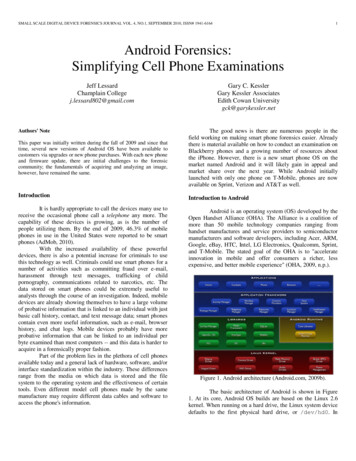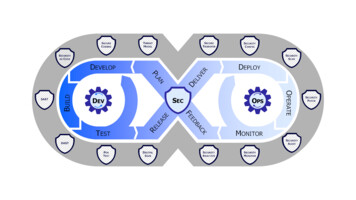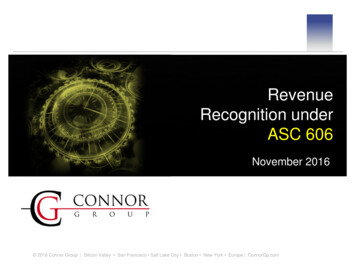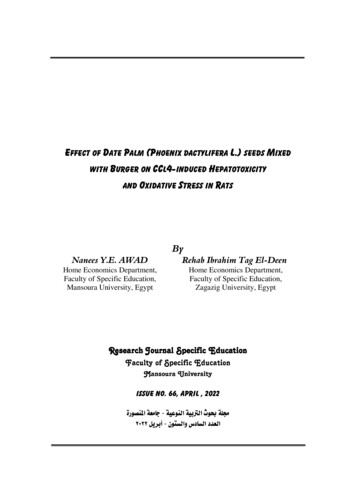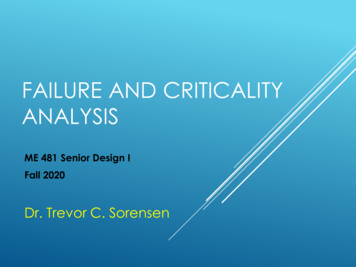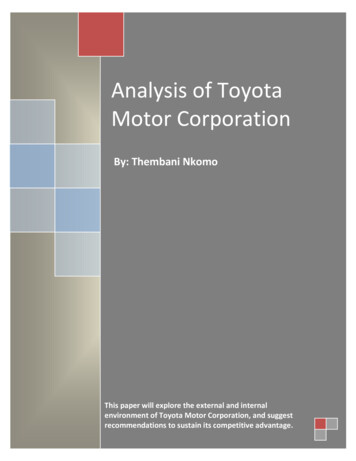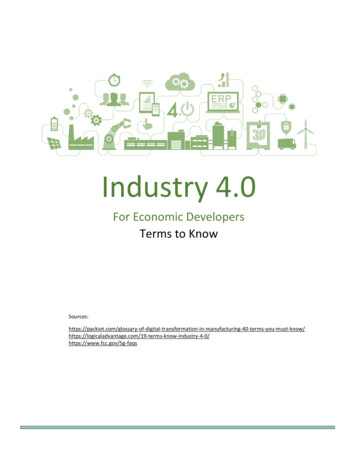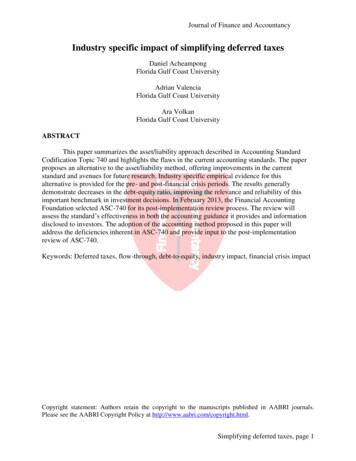
Transcription
Journal of Finance and AccountancyIndustry specific impact of simplifying deferred taxesDaniel AcheampongFlorida Gulf Coast UniversityAdrian ValenciaFlorida Gulf Coast UniversityAra VolkanFlorida Gulf Coast UniversityABSTRACTThis paper summarizes the asset/liability approach described in Accounting StandardCodification Topic 740 and highlights the flaws in the current accounting standards. The paperproposes an alternative to the asset/liability method, offering improvements in the currentstandard and avenues for future research. Industry specific empirical evidence for thisalternative is provided for the pre- and post-financial crisis periods. The results generallydemonstrate decreases in the debt-equity ratio, improving the relevance and reliability of thisimportant benchmark in investment decisions. In February 2013, the Financial AccountingFoundation selected ASC-740 for its post-implementation review process. The review willassess the standard’s effectiveness in both the accounting guidance it provides and informationdisclosed to investors. The adoption of the accounting method proposed in this paper willaddress the deficiencies inherent in ASC-740 and provide input to the post-implementationreview of ASC-740.Keywords: Deferred taxes, flow-through, debt-to-equity, industry impact, financial crisis impactCopyright statement: Authors retain the copyright to the manuscripts published in AABRI journals.Please see the AABRI Copyright Policy at http://www.aabri.com/copyright.html.Simplifying deferred taxes, page 1
Journal of Finance and AccountancyINTRODUCTIONDomestic corporations have been accounting for deferred taxes since the AccountingPrinciples Board (APB) implemented APB Opinion No. 11 (APB, 1967). Deferred taxes occurwhen items are reported on the tax return in different amounts than they are reported on thefinancial statements. The current accounting for deferred taxes is described in FinancialAccounting Standard (FAS) 109 (FASB, 1992) and requires corporations to account for taxesusing the asset/liability approach. FASB’s codification efforts have compiled standards foraccounting for income taxes in the Accounting Standard Codification (ASC) Topic 740 (ASC740). This Codification encompasses all tax related FASB standards (FASB, 2009) and the paperrefers to ASC-740 when referencing the current standards.Recent attempts to reexamine deferred taxes were driven by the International AccountingStandards Board (IASB) and FASB initiative to achieve convergence between FASB’s ASC-740with the International Accounting Standard (IAS) 12 (IASB, 1996). However, these efforts havenot been successful (Fleming, Gill, and Gillan, 2011). In February 2013, the FinancialAccounting Foundation selected ASC-740 for its post-implementation review process. Thereview will assess the standard’s effectiveness in both the accounting guidance it provides andinformation disclosed to investors.This paper briefly summarizes the asset/liability approach described in ASC Topic 740and IAS 12 and highlights the flaws in the current accounting standards. The paper proposes analternative to the asset/liability method offering improvements in the current standard andavenues for future research. Industry specific empirical evidence for this alternative method isprovided for the pre- and post-financial crisis periods. The results generally demonstratedecreases in the debt-equity ratio, improving the relevance and reliability of this importantbenchmark in investment decisions.ACCOUNTING STANDARDS CODIFICATION - TOPIC 740The Codification identifies two principles of income tax accounting: a) to recognize theestimated taxes payable or refundable on tax returns for the current year as a tax liability or asset;and b) to recognize the impact of future tax differentials on assets and liabilities (FASB, 2009,ASC 740-05-5). The first principle relates to taxes due to/receivable from taxing authoritieswhere, until paid/received by the entity, the entity would record a liability/asset. The secondprinciple creates deferred taxes if there is a difference between taxable income versus pretaxincome where the difference was caused by the timing of recognition of income/revenue ordeductions/expenses between tax and financial accounting. These differences are temporarybecause it is expected that they will reverse in the future. According to ASC 740-10-20, thedifferences must be due to past actions that will be resolved by either increasing or reducingfuture taxes.For example, the accelerated depreciation used for tax allows the company to pay asmaller tax bill in earlier years of the life of a fixed asset and pay a higher bill in later years whenthe accelerated depreciation wanes, giving rise to a deferred tax liability in earlier years. This taxliability presupposes that the company will earn a profit in later years. If the company incursoperating losses, taxes will not be paid and the deferred tax liability will have no relevance. Thisflaw in accounting for deferred taxes is one of four criticisms we examine.Simplifying deferred taxes, page 2
Journal of Finance and AccountancyFLAWS IN THE CURRENT ASSET/LIABILITY METHODColley, Rue and Volkan (2010) highlight four flaws in the current asset/liability approachdescribed in FAS 109 and discussed in ASC 740. Each of the four criticisms appears below.Inconsistent Individual and Aggregate MeasurementsThe unit problem focuses on the level of aggregation that should be used to account fortransactions/events as either an individual event or an aggregation of like-kind events (Devine,1985). Individual versus aggregate categorization of events will lead to a difference inaccounting for the financial statement elements. FASB has taken both approaches in creating thedeferred tax standards. For example, warranty expense is approached using the aggregate view inthat all sales of a warranted item are grouped together, an estimate of warranty claims is made,and the resulting expense/liability is recorded. Individual calculation of each warranty claim isnot made (Colley, Rue and Volkan, 2010). In the case of income tax calculations, FASB isinconsistent, advocating aggregate calculations in some areas and individual calculations inothers (Colley, Rue, Valencia, and Volkan, 2012).In ASC 740-10-10, the FASB recognizes that identifying the specific future impact ofcurrently recorded transactions is unrealistic because taxes are based on all items on the taxreturn which result from current and past years’ events. In addition, the attribution of the impactof specific transactions on taxes is arbitrary and requires aggregate estimates (ASC 740-10-10-2;FASB, 2009).In the area of temporary differences (taxable or deductible) which lead to deferred taxesan individual perspective is taken as the FASB looks at the reported amounts of assets andliabilities that will be recovered and settled, respectively. Based on that assumption, a differencebetween the tax basis of an asset or a liability and its reported amount in the statement offinancial position will result in taxable or deductible amounts in some future year(s) when thereported amounts of assets are recovered and the reported amounts of liabilities are settled (ASC740-10-25-20; FASB, 2009).Unreliable AllocationsASC 740 and the asset/liability method account for unrealized taxes/deductions (deferredtaxes) as realizable and allocate them over future periods. However, these unrealized taxes anddeductions (deferred taxes) are essentially an element of wealth redistribution created by taxingauthorities and should not be allocated over future periods as required by ASC 740. Thisapproach is flawed for several reasons:1.2.3.4.Deferred taxes do not satisfy the definition of an expense;Taxes are an element of wealth redistribution rather than revenue generation;Unrealized future taxes/deductions do not create liabilities/assets because future taxableincome is uncertain; andAccounting theory and standards prohibit the anticipation of future income.Statement of Financial Accounting Concept No. 6 (Statement 6), paragraph 81 makes itclear that current taxes are expenses; but the statement does not include the deferred portion ofSimplifying deferred taxes, page 3
Journal of Finance and Accountancythe current tax provision since the latter does not fit the definition of an expense (FASB, 1985).Statement 6 (FASB, 1985) continues in paragraphs 146 – 149 to classify expenses into threecategories: 1) matched with revenue (cost of goods sold); 2) period costs (selling expenses); and3) the cost of assets benefiting future periods using systematic and rational allocation into thefuture (depreciation). Taxes paid in the period are a period cost. Thus, future taxes (deferredtaxes) do not represent a cost of assets that benefit future periods and future allocations are notappropriate.Flawed Definitions of Assets/LiabilitiesUnrealized future taxes/deductions do not create liabilities/assets due to the uncertainty offuture taxable income. Concept Statement 6, paragraph 35 defines liabilities as probable futuresacrifices of economic benefits arising from present obligations to transfer assets to other entitiesas a result of past transactions or events and paragraph 25 defines assets as probable futurebenefits under the control of an entity (FASB, 1985). At first blush, deferred taxes would seemto be a liability/asset. However, the income tax due/refundable in the future is based on futureevents, not on past events, and thereby violates the definition of a liability/asset as it is debatableas to the obligation of the entity or the ability of the entity to control the deferred taxliability/asset. However, it is possible to characterize the deferred tax/benefit as a contingency.According to ASC 450-10-20 a contingency is an existing condition involving uncertainty as topossible gain (gain contingency) or loss (loss contingency) that will be resolved when one ormore future events occur or fail to occur (FASB, 2009). Thus, treating deferred taxes as acontingency rather than an asset/liability makes more sense.Under ASC 740, a deferred tax asset is reduced by a valuation account if the entityanticipates an inability to utilize the benefits provided by the asset. The standard takes intoconsideration the likelihood that the deferred asset may not be fully useable to offset futuretaxable income; however, it does not account for a deferred tax liability the same way.Essentially, the standard acknowledges possible loss contingencies (recognized assets may not berealized), but not gain contingencies (recognized liabilities may not be incurred). This treatmentis consistent with the accounting for contingencies and lends support to referring to deferred taxasset/liabilities as contingencies.Flawed Definitions of Temporary Differences: The Fallacy ofTemporary Differences Related To DepreciationFASB recognizes that some temporary differences may not reverse and exempts suchdifferences from deferred tax recognition in ASC 740-10-25-3 (FASB, 2009). Depreciation is notone of the differences exempt from recognition under the current standard. However,depreciation differences fail to reverse when aggregated in asset groups and should therefore beexempt from recognition as a deferred tax. Aggregate deferred tax liabilities from depreciationstay on the balance sheet until the company reaches its life expectancy and stops purchasingfixed assets. Therefore, the only time aggregate depreciation differences reverse is when thecompany is no longer active in that business arena. It difficult to define this type of a timingdifference as temporary as it is likely that depreciation differences will remain on the books fordecades and thereby act more like permanent differences that should avoid accounting treatmentall together.Simplifying deferred taxes, page 4
Journal of Finance and AccountancyEmploying conservative assumptions of asset replacement at constant prices, profitabilityeach year, and no growth after a short startup period, the deferred tax liability grows each yearduring the startup period and remains constant during the period when worn out assets arereplaced. Thus, in years beyond the startup period, income tax expense equals income taxpayable - effectively supporting an argument for the use of the flow through method discussedbelow. The quasi-permanent deferred tax liability that remains on the statement of financialposition under the current standard overstates the entity’s liabilities. If we relax the assumptionof profitability each year, Colley, Rue and Volkan (2010) illustrate the results that occur whenincome varies and net losses are reported. An operating loss carryback/carryforward, dependingon the significance of the loss, will negate the company’s ability to take advantage of thedepreciation differences and refute accounting for depreciation differences as temporary.Temporary differences that do not reverse in the foreseeable future should not createdeferred taxes as they act more like permanent differences. Treating them as temporarydifferences creates an added liability on the statement of financial position which does notprovide relevant or reliable information for users of the financial statement. To address the flawsin ASC-740, we propose an alternative to the current accounting standards.ALTERNATIVE TO TOPIC 740An alternative to the current asset/liability approach is proposed in this paper with thegoal of presenting a method that may be adopted for global reporting, namely, the flow throughmethod with a contingent tax asset/liability reported in the notes to financial statements. Theflow through method is addressed in numerous articles (e.g., Colley, Rue, and Volkan, 2010;Colley, Rue, Valencia, and Volkan, 2012). Income taxes owed on the tax return are simplyreported on the income statement as income tax expense. This method is the simplest and leastcostly method to apply. In addition, the contingent tax asset/liability is reported for taxesreceivable/due that are expected to occur in the forecast horizon.The flow through method for accounting for income tax expense is simple in that incometax expense equals the amount of income taxes payable to the taxing authorities during theaccounting period. Income tax expense is treated as a period cost, is expensed in the periodincurred, and not allocated over future periods. Due to the uncertainty of future taxable income,no asset or liability is recorded for the difference between taxable income and pretax income.However, those timing differences that are more likely than not to occur and can be reasonablyestimated are reported in the notes as contingencies.LARGE-SCALE EMPIRICAL ANALYSESWhile deferred taxes influence many managerial policies related to debt such as debtrefinancing decisions (e.g., Harrington, Smith, and Trippeer, 2012), the debt-to-equity (DTE)ratio was chosen for analysis because it is an important indicator of managerial competence. Tosee the impact on the DTE for entities reporting deferred tax amounts, thousands of companiesare studied in 21 industries over a seven-year period using the deferred tax balances of firms inthe COMPUSTAT database (referred to as CT from this point forward). The data set includescompanies reporting a deferred tax position over the period 2004-2010. The CT variablesTXNDBL [the net accumulated deferred tax liability – a credit balance] and TXNDB [the netaccumulated deferred tax asset (liability) – a net debit (credit) balance] are used for the analysis.Simplifying deferred taxes, page 5
Journal of Finance and AccountancyBoth of these variables represent the temporary asset/liability differentials that result fromreporting different amounts for financial reporting and tax purposes. The former is the liabilityposition and the latter is the net asset or liability position. TXNDBL is a positive amount andTXNDB is a positive amount for net asset positions and a negative amount for net liabilitypositions. Observations with negative common stockholders’ equity and extreme outlierobservations (DTE ratios greater than or equal to 5) are removed. The trends in the deferred taxbalances for a full sample consisting of 38,926 firm-year observations are investigated.Additional analyses are conducted on 21 smaller industry specific samples, where industries aredefined by the main Standard Industry Classification (SIC) codes.MethodologyThe reported debt-to-equity ratio (DED – where D stands for deferral) calculated viaASC 740 is compared to an adjusted debt-to-equity ratio reflecting the elimination of netaccumulated deferred taxes (DEF – where F stands for flow through) to represent the alternativemethod. For purposes of estimating DEF, TXNDBL is deducted from total debt (numerator) anddeducted TXNDB (positive for net asset positions and a negative for net liability) from totalequity (denominator). The adjusted ratio (DEF) was based on the idea that no deferred taxeswere recorded in the past. This resulted in lower liability and higher or lower equity balances(depending on whether TXNDB was a net asset or liability position). For each year, thedifferences between DED and DEF were computed; this was done for firms in the overall sampleas well as for firms in each of the 21 industry classifications. Finally, the process was repeatedfor all 21 industries using the pre-recession (2004-2007) and post-recession (2008-2010) periodsto determine if the financial crisis had a differential impact on the industries analyzed.RESULTSTable 1 (Appendix) presents the 2004-2010 results for the entire sample and for each ofthe 21 industries. The analyses for the entire sample (the first raw of Table 1) indicate that, asexpected, the debt-to-equity ratio declines when the alternative method is used (DEF). Inaddition, results show that annual declines range between a high of 12.5% in 2010 and a low of10.7% in 2007 and 2008, with an average decline of 11.3% over the 2004-2010 period. Thus,the results show a very stable pattern with small fluctuations from year to year. This patternmatches the predictions and assertions that were made in the discussion above. Since it is logicalto assume that individual deferred tax balances eventually reverse, firms appear to be engagingin strategies that prevent the aggregate deferrals from reversing.The decreases in the DTE ratios were statistically significant (p-value .05) for allindustries, for all years, and for each year. While the same pattern generally held during theindustry-based analyses, there were exceptions in certain industries. With 37 of the 176 (21%)observations where the differences were not statistically significant, construction, textiles, rubberand plastic, household goods, electronics, motor vehicles, and banking industries led the way.Moreover, seven of the 176 (4%) observations resulted in increases in the DTE ratios when flowthrough approach was used (negative differences) indicating that the net deferred tax balanceswere assets for those industries during the years in question. However, none of the negativedifferences were statistically significant with the largest difference being an increase of 3.5%during 2007 in the construction industry.Simplifying deferred taxes, page 6
Journal of Finance and AccountancyThe global examination of Table 1(Appendix) shows that the use of the flow throughmethod will lead to a decrease in the DTE ratio. While there are seven increases, the differencesare not statistically significant, are very small in magnitude, occur in the years impacted by thefinancial crisis, and show no industry concentration. The remaining 30 observations that indicatedeclines in the DTE ratio but are not statistically significant are concentrated in textiles (6),household goods (5), construction and motor vehicles (4 each), rubber/plastics and electronics (3each), drugs/medical and financial (2 each), and real estate (1), and can be analyzed as follows:1. Textile industry has been waning for decades and most deferred tax balances are used up.2. Motor vehicles and construction were significantly impacted by the economic crisis and wentthrough massive restructurings, using up most, if not all, deferred tax balances in the process.These balances declined along with all other assets and liabilities when bankruptcies and otherforms of legal procedures caused these entities to use fresh start accounting procedures.3. Results for household goods, electronics, drug/medical, and rubber/plastics are all connectedto the economic crisis. Electronics industry results are leading indicators while the other twotrack the economic decline.4. In the financial and real estate sectors, unrealized gains/losses in the fair valuation of securitiesand other investments explain the decrease of deferred tax balances. As economic activity inthese sectors decline, deferred taxes are used up to match against taxes due or create negative taxexpense (credits).To understand if the financial crisis had a differential impact on industry based results,the analyses were extended to two time periods: pre-crisis (2004-2006) and post-crisis (20072010) to observe if these results (see Table 2 in Appendix) tracked the results in Table1(Appendix). Analysis of Table 2 (Appendix) indicates that results generally confirm theobservations in Table 1 (Appendix). Because of the use of multi-year periods, all observationsshow decreases in the DTE ratio. The results that are not statistically significant show the sametrends and are concentrated in the same industries as the ones in Table 1 (Appendix).The evidence presented shows that using the alternative method to account for incometaxes significantly decreases the DTE ratio for most firms, improving their financial position.The consistency in differences over the entire sample, in individual industries, and in pre- andpost-crisis periods is remarkable.CONCLUSIONS AND SUGGESTIONS FOR FUTURE RESEARCHThe current reporting requirements for deferred taxes are complex and costly to apply.The ever-increasing net deferred tax liability position for many firms does not appear to bereversing, thereby giving rise to the concern that temporary differences are other thantemporary. Thus, a re-examination of the current standard may be justified. This paper examinesfour flaws in the current standard and proposes an alternative method that results inimprovements in the DTE ratio. The proposed alternative is logical if taxation is the act oftransferring wealth to a government for permission to engage in business activities in thatjurisdiction. Under the proposed alternative, the tax expense is equal to taxes paid and thedeferred tax assets and liabilities are eliminated.At best, deferred taxes represent contingencies since tax policies allow firms continuedeferring taxes at the aggregate level indefinitely, making it probable that the temporarydifference will not reverse in the foreseeable future. If it is more likely than not that the deferredSimplifying deferred taxes, page 7
Journal of Finance and Accountancytaxes will reverse, it is appropriate to report those amounts in the footnotes of the financialstatements.The proposed method may facilitate global convergence of accounting for inter-periodtax allocation. With convergence around the corner, now is the time for a change. If the methodproposed in this paper does not take root, FASB should consider exempting depreciation as atemporary difference in industries where depreciation acts more like a quasi-permanentdifference. Although this would not address all the inherent deficiencies of ASC-740, it wouldlessen the impact these flaws have on company balance sheets and provide input to the postimplementation review of ASC-740 by the Financial Accounting Foundation.Future research may examine the behavior of the deferred tax balances over time,normalized by a suitable variable such as total assets. In addition, the persistence of increases indeferred tax balances over time and in different industries may be analyzed. Finally, the impactof eliminating the deferred taxes on the financial ratios in industries with high deferred taxbalances versus industries with low deferred tax balances may be computed.REFERENCESAccounting Principles Board. (1967). Opinion No. 11: Accounting For Income Taxes. NewYork, NY.Colley, R., Rue, J., Valencia, A., & Volkan, A. (March 2012). Accounting for deferred taxes:time for a change. Journal of Business and Economics Research, 10:3, pp. 149-156.Colley, R., Rue, J., and Volkan, A. (January 2010). Deferred taxes in the context of the unitproblem. Journal of Finance and Accountancy, 2, 4-14.Devine, C. (1985). The unit problem - Essays in accounting theory, Volume II. Sarasota, FL:American Accounting Association.FASB. (2009). Accounting standards codification: Topic 450 – Contingencies. Norwalk, CT.FASB. (2009). Accounting standards codification: Topic 740 – Income taxes. Norwalk, CT.FASB. (1992). Financial accounting standard 109 - Accounting for income taxes, Norwalk, CT.FASB (1985). Statement of financial accounting concept No. 6 – Elements of financialstatements. Norwalk, CT.Fleming, D.M., Gill, S. L., & Gillan, S. (May 2011). Accounting for income taxes: a misfit inthe convergence of standards? Strategic Finance, 81:5, pp. 49-53.Harrington, C., Smith, W., & Trippeer, D. (October 2012). Deferred tax assets and liabilities:tax benefits, obligations and corporate debt policy. Journal of Finance and Accountancy,11, pp. 1-18.IASB. (1996). IAS 12 – Income Taxes. London: United Kingdom.Simplifying deferred taxes, page 8
Journal of Finance and AccountancyAPPENDIXTable 1: Difference in the Means of DED and DEF for all years and all industriesAll20042005 2006 2007 2008 2009 2010YearsAll industries.113 .120.114 .110 .107.107 .113.125Mining.074 .055.074 .066 .088.082 .074.072Petroleum and.185 .210.174 .189 .181.200 .166.175Natural GasConstruction.047 .130.021* .030* -.035* .047* .060.089Food Products.204 .212.225 .214 .194.157 .192.237Textiles.024* .022* .047* .017* -.005* .047* .025* .012*Wood & Paper.258 .345.291 .299 .214.250 .226.153Printing,.200 .170.198 .207 .212.184 .215.233Publication &CommunicationChemical and.089 .138.115 .064 .084.048 .082.094Allied ProductsDrugs & Medical.014 .004* .013 .017 .014.012* .018.019EquipmentRubber & Plastic.060 .124.107 .093 .038* .009* -.030* .061*Steel, Metals,.051 .043.056 .058 .070.034 .044.053Machinery &EquipmentHousehold Goods.030 .069-.012* .001* .043* .017* .019* .073*Electronics.009 .006* .003* .017 .018.016* -.003* -.001*Motor Vehicles.065 .048* .031* .043* .104.041* .080.120Transportation.267 .341.298 .243 .242.246 .256.243Utilities.748 .804.768 .723 .677.732 .734.798Wholesalers.086 .080.085 .071 .126.052 .076.114Retailers.135 .103.108 .110 .124.158 .170.193Bank, Insurance.017 .013* .012* .017 .018-.003* .030.033& FinanceReal Estate.166 .095* .156 .175 .154.193 .194.209Services.049 .042.038 .034 .038.065 .064.072Notes: * indicates the test of difference is not statistically different from zero at the .05 level.Simplifying deferred taxes, page 9
Journal of Finance and AccountancyTable 2: Differences in means (DED – DEF): pre- and t-CrisisAll industries.113.113.115Mining.074.072.076Petroleum and.185.188.181Natural GasConstruction.047.036*.065Food Products.204.211.194Textiles.024*.021*.029*Wood & Paper.258.288.210Printing, Publication.200.196.209& CommunicationChemical and Allied.089.099.074ProductsDrugs & Medical.014.012.016EquipmentRubber & Plastic.060.091.011*Steel, Metals,Machinery &.051.057.043EquipmentHousehold Goods.030.025.037*Electronics.009.011.005*Motor .135.111.173Bank, Insurance &.017.015.020FinanceReal Estate.166.147.198Services.049.038.067Notes: * indicates the test of difference is not statistically different from zero at the .05 levelSimplifying deferred taxes, page 10
The current accounting for deferred taxes is described in Financial Accounting Standard (FAS) 109 (FASB, 1992) and requires corporations to account for taxes using the asset/liability approach. FASB's codification efforts have compiled standards for accounting for income taxes in the Accounting Standard Codification (ASC) Topic 740 (ASC-740).



